#Camillian Sisters
Text
Saint of the Day - 23 February - Saint Josephine/Giuseppina Vannini (1859-1911)
Saint of the Day – 23 February – Saint Josephine/Giuseppina Vannini (1859-1911)

Saint of the Day – 23 February – Saint Josephine/Giuseppina Vannini (1859-1911) “A woman of prayer and sacrifice” – Religious Sister and Founder together with Blessed Louis (Luigi) Tezza MI (Camillian) (1 November 1841 – 26 September 1923), of the religious congregation known as the Daughters of Saint Camillus, of which Order she is the Patron. Born as Giuditta Vannini on 7 July 1859 at Rome…
View On WordPress
4 notes
·
View notes
Text

18th March >> (@Zenitenglish By Deborah Castellano Lubov) #PopeFrancis #Pope Francis: ‘From Mary, We Learn How to Be Next to the Suffering, With a Mother’s Tenderness’. Addressing Religious Men and Women of Camillian Charismatic Family, Pope Francis Affirms How Tenderness Is Fundamental Aspect of their Work to Help the Ill
Tenderness and Christianity must go hand in hand…
Pope Francis stressed this today, March 18, 2019, when addressing the Camillian Charismatic family, stressing how loving service to the sick, means being also tender.
Francis reminded them that they are accompanied and guided in their work to the ill by the Virgin Mary, Health of the Sick and Mother of the Consecrated. “From Her,” he expressed, “we learn how to be next to those that suffer with tenderness and the dedication of a mother. I pause a bit on this word ‘tenderness.’”
“It’s a word that today risks being dropped from the dictionary!” he warned, adding: “We must take it up again and implement it! Christianity without tenderness isn’t right.”
Tenderness, the Pope highlighted, is in fact a Christian attitude. “It’s also the ‘marrow’ of our meeting with persons that are suffering.”
The Holy Father praised that they are “constantly committed” in a “loving and generous donation” to the sick, “carrying out a precious mission” in the Church and in society, next to the suffering.
“When sickness comes to disturb and sometimes to overwhelm our life,” he reminded, “then we feel intensely the need to have next to us a compassionate and also competent brother or sister, who consoles us, supports us, helps us to recover the precious good of health, or who accompanies us to the threshold of our final encounter with the Lord!”
The entire Church as a whole, he noted, has received from her Master and Lord the mandate to proclaim the Kingdom of God and take care of the sick , in imitation of Him, the Good Shepherd, the Good Samaritan, who went through this earth “doing good and healing all those that were prisoners of sickness”
God, Francis pointed out, bestowed to Saint Camillus of Lellis and to all those who follow his example, “the gift to relive and witness Christ’s merciful love to the sick.”
Pope Francis concluded, praying to the Holy Spirit to sustain this new stage of your journey as Camillian Charismatic Family, blessing them, their communities and those they care for, and asking them to pray for him.
Here is the Vatican-provided text:
***
Dear Sisters and Dear Brothers,
It’s with joy that I receive you all, representatives of the various expressions of the Camillian Family! I greet you affectionately and thank Father Pessini for his words. And I ask the Lord to keep his sense of humour: You will never have a stomach ulcer!
You are constantly committed in a loving and generous donation to the sick, carrying out a precious mission in the Church and in society next to the suffering.
When sickness comes to disturb and sometimes to overwhelm our life, then we feel intensely the need to have next to us a compassionate and also competent brother or sister, who consoles us, supports us, helps us to recover the precious good of health, or who accompanies us to the threshold of our final encounter with the Lord!
The entire Church as a whole has received from her Master and Lord the mandate to proclaim the Kingdom of God and take care of the sick (Cf. Luke 9:2), in imitation of Him, the Good Shepherd, the Good Samaritan, who went through this earth “doing good and healing all those that were prisoners of sickness” (Common Preface VIII). However, in particular, God bestowed to Saint Camillus of Lellis and to all those who follow his example, the gift to relive and witness Christ’s merciful love to the sick. The Church has recognized it as an authentic charism of the Spirit. You live it in an exemplary way, translating it into life according to the double binary of assisting directly the sick, especially the poorest, in their corporal and spiritual needs, and to teach others the best way of serving them for the benefit of the Church and of humanity.
All charisms “are gifts that the Holy Spirit gives us [. . . ] Gifts <that are> given, not to be hidden, but to share with others. They are not given for the benefit of the one who receives them but for the benefit of the People of God. If, instead, a charism is used to affirm oneself, one must doubt that it’s an authentic charism or if it’s faithfully lived. Charisms are particular graces given to do good to many others” (Catechesis, November 6, 2013). They always have a transitive character: they are directed to others. In the course of the years you have striven to embody your charism with fidelity, translating it into a multiplicity of apostolic works and into pastoral service for the benefit of suffering humanity worldwide.
In the wake of this mission, which some members of your Religious Families have lived heroically, becoming model of holiness, you are called to continue your service in a prophetic way. It’s about looking at the future, open to the new ways of apostolate that the Spirit inspires you and that the signs of the times and the needs of the world and of the Church require. The great gift you have received is still relevant and necessary also for this our time, because it’s founded on charity, which will never end (Cf. 1 Corinthians 13:8). As a living part of the Church, sent to spread the Gospel so that men “may have life and have it abundantly” (John 10:10), you have the wonderful opportunity to do so precisely through gestures of the care of life and of integral salus, so necessary also in our time.
To the charism inspired initially in Saint Camillus, various ecclesial realities were gradually incorporated, which today form a unique constellation, namely, a “charismatic family” made up of men Religious, women Religious, lay consecrated and lay faithful. None of these realities is, on its own, sole custodian or holder of the charism, but each one receives it as gift and interprets and actualizes it according to his/her specific vocation in the various historical and geographical contexts. The original charism remains at the center, as a perennial source of light and inspiration, which is included and embodied dynamically in the various forms. Each one of those is offered to the others in a mutual exchange of gifts that enriches all, for common use and in view of the implementation of the mission itself. What is it? To witness in every time and place the merciful love of Christ for the sick.
Saint Camillus of Lellis, whom you all acknowledge as “Father,” lived at a time when the possibility had not yet matured of an active consecrated life for women, but only that of a contemplative and monastic type. Therefore, he established an Order only for men. However, he understood well that the care of the sick should be practiced also with the typical attitudes of the feminine spirit, so much so as to ask his Religious to serve the sick “with that affection that a loving mother usually has for her only sick son” (Rules of the Company of the Servants of the Sick, 1584, XXVII). The two feminine Congregations that arose in the 19th century, and the Secular Institutes born in the last century have given completeness to the expression of the charism of mercy to the sick, enriching it with the outstanding feminine quality of love and care. You are accompanied and guided in this by the Virgin Mary, Health of the Sick and Mother of the Consecrated. From Her we learn how to be next to those that suffer with tenderness and the dedication of a mother. I pause a bit on this word “tenderness.” It’s a word that today risks being dropped from the dictionary! We must take it up again and implement it! Christianity without tenderness isn’t right. Tenderness is in fact a Christian attitude; it’s also the “marrow” of our meeting with persons that are suffering.
Dear brothers and sisters, I encourage you to cultivate always communion among you, in that synodal style that I have proposed to the whole Church, in listening to one another and all women and all men in listening to the Holy Spirit, to appreciate the contribution that every individual reality offers the one Family, so as to express more thoroughly the multiple potentialities that the charism encloses. Be always increasingly aware that “it’s in communion, even if it costs effort, that a charism is revealed authentically and mysteriously fruitful” (Apostolic Exhortation Evangelii Gaudium, 130). In fidelity to the initial inspiration of the Founder and of the Women Founders, and in listening to the many ways of suffering and of poverty of today’s humanity, you will thus be able to make the gift received shine with an ever new light; and many young women and many young men worldwide will be able to feel attracted by it and join you, to continue to witness God’s tenderness.
Dear brothers and sisters, I pray to the Holy Spirit to sustain this new stage of your journey as Camillian Charismatic Family. From my heart I bless you all, your communities and the persons you serve — all. And, please, do continue to pray also for me Thank you.
[Original text: Italian] [ZENIT’s translation by Virginia M. Forrester]
18th MARCH 2019 14:49POPE AND HOLY SEE
1 note
·
View note
Text
blog no. 11 - a life-giving experience at bahay kanlungan
It’s sad to think that the world is full of wicked problems and conflicts that seem like they’re beyond our control. It’s overwhelming to see the struggles of other people and feeling like you can’t do anything about it. I think that the struggle for most of us is that we want to make a change and leave a positive impact on the world, but we don’t know exactly where or how to start. We have good intentions for society but it seems like we can never put to action our visions and goals.
Fortunately, there is a program in the Ateneo that may give us a glimpse of the social issues that is present in our society. The Binhi Program is a one-of-a-kind experience offered to students by the Ateneo to provide them with first hand experience and encounters with the marginalised sectors in our society. Its goal is to shed light on certain issues that affect our brothers and sisters. Ultimately, we are motivated to take action and to respond to these problems.
We had our immersion last March 16 at The Camillian Sisters Bahay Kanlungan in Antipolo, Rizal which is a nursing home for elderly women. The misconception about facilities like Bahay Kanlungan is that families, who are unable to take care of their old relatives, abandon them in the nursing home and never being able to visit them. Surprisingly, I was able to talk to some lolas and I found out that they liked it there— it was their own personal choice to stay in Bahay Kanlungan to spare their families from taking care of an “old, sickly lady” according to them. Upon hearing this, I can’t help but feel sad yet inspired because of such selfless decision they made to make their families’ lives “easier.” It’s also nice to see that they were able to find a home with their new friends in Bahay Kanlungan. The staff was also very welcoming and they showed genuine care for the lolas in the nursing home. In fact, Ate Pau who is one of the caregivers, told me that it’s as if she’s caring for her own mother and that she has developed a familial bond with the staff and the elderly. Bahay Kanlungan is a second chance for the elderly to find a home that will care for them until the end.
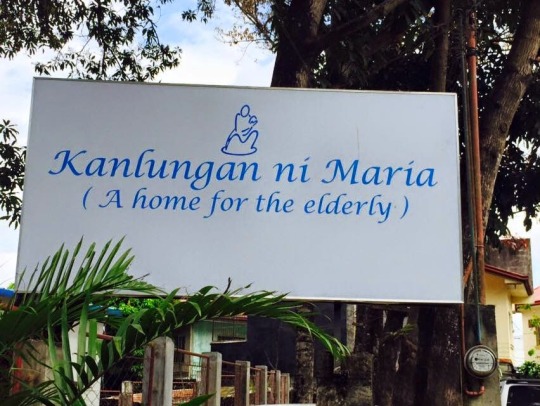
In Bahay Kanlungan, I think what they value most is time and family. In our fast-paced modern world, we tend to take for granted the time we have with our families. Soon enough, our parents will grow old and I only hope that we stick by them and never leave their side. They did their best to be good parents and when it’s our turn to take care of them, I hope we are able to take responsibility despite how hard it may be. In Bahay Kanlungan, they made a family where every moment of every day, is a reminder that there is still time to make things better.
The Binhi Program made me step out of my comfort zone. As an emotional person, I expected myself to cry a lot during the immersion. Surprisingly, I was filled with inspiration because I was able to witness the strength and the positivity of the people in Bahay Kanlungan. I saw that simple moments like dancing and singing can already be a source of happiness for them. It made me appreciate the time I have here on earth and to value my family more. More importantly, it made me to value the simple things in life and to reevaluate what’s truly important— time, love, and family.
I think that people should give this experience a chance. It was truly life-giving yet sad at the same time. However, this sadness would motivate individuals to step up and help the elderly sector in the community. They are the ones who have nurtured us and moulded us to become good people, and it’s right and just that we give them the care and love they deserve. Society, in general, should give them financial, spiritual, and emotional support because at this point in their lives, they only want to be taken cared of, to be valued, and to have a family with them until they are ready to go.
0 notes
Photo

Ang sarap nitong Bagnet Bagoong. Bili na kayo sa Barbantini sa Camillian Sisters Maria Domenica or PM @pangan.ellen #bagnetbagoong https://www.instagram.com/p/BvwG1B7h_bXHh6G8uDd1UcsX4Qz65Zo0ynSKp40/?utm_source=ig_tumblr_share&igshid=orqplvp0zam1
0 notes
Text
Benefits of Fear

“Why am I afraid to say who I am?” This is the question that Father John asked our class yesterday (5/15), on the first day of CPE, with the recognition that all people struggle with it. I reflect on my own life and ministry and recognize that it is hard to trust and it is hard to be vulnerable. Perhaps that is the barrier that keeps people from being known. Just three years ago, I was extremely scared to admit that I wanted to pursue ministry. My entire life I dreamt of pursuing medicine, and I have a Bachelors degree in Biology to prove it. That degree is one of the things that I am most proud of and yet as I continued to discover myself, I felt called to a different path; a path that invited me into the unknown and channeled my fears; a path that led my heart to Africa.
Today, it is my fourth day in Kenya where I am serving as a hospital chaplain for the next 10 weeks. Fear is accompanying me again but it is pushing me into new depths of happiness…
I had no idea that traveling from Ghana to Kenya would highlight the great diversity of Africa. A six hour plane ride transported me from the hot Ghanaian sun to the cool Kenyan air. On Saturday (5/13) morning, I stepped off the plane and was greeted by Kenyans bundled in winter coats while my entire body felt refreshed to embrace the 60 degree temperature. As Joshua, my taxi driver, drove me to Servants of the Sick Training Center, I stared out the windows completely mesmerized by the rich vegetation and development of Nairobi. Tall buildings outline the city with forest preserves and parks defining its beauty. A road characterized by round-a-bouts and the President’s estate led us to Servants of the Sick, a tangerine colored building surrounded by a large green gate labeled with the word “Camillians” in red. The Camillian’s are an order of Catholic priests who dedicate their ministry to serving the sick with a commitment to hospital chaplaincy.
Entering the 4 story building, I was welcomed home by Josephine, our kind-hearted cook, and Father Francis, a 34 year old Camillian priest. My first day in Nairobi was spent with him. He took me to the neighboring community of Karen where the Camillian’s are located; we visited the seminary and sister’s convent. Each community welcomed us with traditional Kenyan food and the Swahili words, “Karibu Sana” (you are most welcome). It was a whirlwind of a day where I felt hospitality in its purest form. The first night in Kenya, I fell asleep under my mosquito net, in complete awe that my fears and nerves about Kenya were surpassed by love.
On Sunday (5/14), Francis and I began the day with a breakfast of porridge, a thick brown liquid mixed with sugar and lemon. This would nourish us for a day at Nairobi Hospital where I observed Francis complete his duties as hospital chaplain. Nairobi Hospital is the largest private hospital in Kenya. It is characterized by it's cleanliness, welcoming atmosphere, and quality of care. First, Francis led Sunday mass at the hospital chapel, a small narrow room full of wooden chairs and crosses. Afterwards, I joined him to visit patients. I was originally nervous and anxious about this but my fear was overcome with happiness when I sat with a sick 1 year old, a laboring woman (whose new baby boy I would meet the next day), and an older woman with a broken foot. It might be strange to say these situations made me happy but these patients invited me into their vulnerability which is transforming and life giving. I find happiness in encountering humanity.
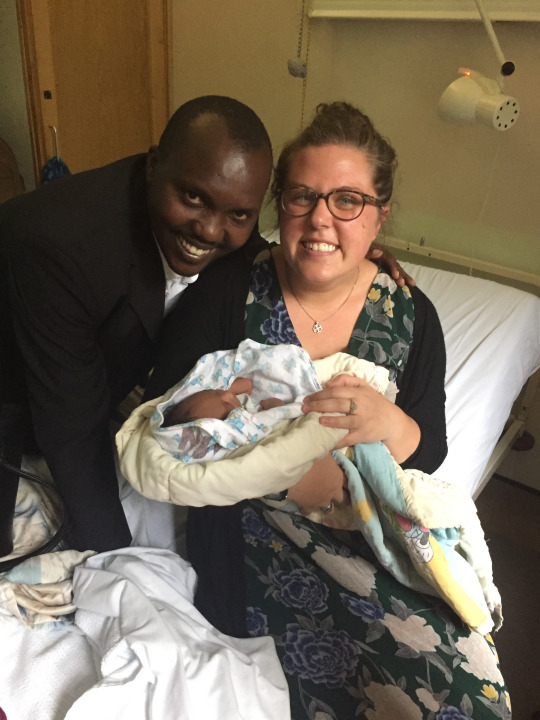
(Picture: Father Francis and baby boy, Gabriel)
Next I met Florence, a 23 year old nursing student and my new friend. She gave me a tour of the entire hospital adding her personal stories and perspective. I was amazed by its beauty and the bright yellow walls that hold pain and sorrow but also joy and life. As I toured, I witnessed a dad meet his baby for the first time. His smile was brighter than the yellow walls.
The pristine condition of Nairobi Hospital was highlighted when Florence took me across the street to Kenyatta National Hospital, the largest government hospital in Kenya and the place where I will complete my chaplaincy. Grey colored walls with blue accents draw visitors into its chaos. We arrived during visiting hour where hundreds of people gather to see their loved ones. Climbing the stairs to tour the wards meant getting stuck in a mass of people with a pungent smell of body odor. Each hospital bed held two-three patients. The children were covered in ring worm. The hospital rooms were covered in a film of dirt. The contrast between the two hospitals was huge and I felt fear begin to surface as I realized what I will have to witness over the next ten weeks at Kenyatta.
While touring the hospital, Florence and I discussed topics like music, food, family, and politics. This August, a new president will be elected in Kenya. The last election was in 2008 which led to mass killings when there was competition between tribes. Florence recalled the day of the election. When the results were announced she was at school which led to disarray and chaos. With gun shots fired, the entire school ran to the court yard in panic. Florence remembers one of her pregnant teachers being trampled causing her to miscarry her unborn baby. Soon after, the teacher was shot and killed in front of the school. The teacher’s daughter witnessed her mother’s murder. These stories are not easy to hear but I thank Florence for her willingness to share these hard stories revealing an undeniable strength of the Kenyan people. She expressed her fears for the upcoming election. I pray that this country does not have to relive its past.
My weekend experience at the hospital prepared me for class on Monday (5/15). Our class is comprised of twelve students (8 priests, 1 brother, 2 sisters, and me). The biggest surprise was learning that a priest (Gerald) and brother (Morris) were from the Congregation of the Holy Cross. I felt an immediate bond with them as we talked about the founders of the Congregation and dropped words like “Spes Unica.” I feel a strong desire to live the mission of the Holy Cross and having the opportunity to encounter this community in Kenya is surreal.
Along with my classmates, we have two supervisors who will accompany us throughout the course. While being oriented to hospital chaplaincy, today (5/16) we found out our placements for the summer. I will be serving as a chaplain at two hospitals: 1) Mathari Hospital, an institution of 600-800 patients suffering from mental illness, and 2) Kenyatta National Hospital’s burn unit. I am extremely hopeful that both of these places will help me grow.
I will admit that I have fears of seeing a patient completely burned, most likely from abuse. And I have other fears of not being able to understand severe mental illness. But Deacon Meschk, one of our supervisors, reminded us today: “What you fear the most will benefit you the most.”
That leads me back to the original question posed by Father John: “Why am I afraid to say who I am?” I am continuing to reflect on this question with insight that allowing yourself to be known has profound benefits. It is my hope that I can truly know my patients. That I can help ease their fears and conquer my own. As I do so, I know that it is that same fear that is accompanying me to new depths of happiness. I am overwhelmed with gratitude that life, coupled with fear, led me here.
2 notes
·
View notes
Text
Catholic Religious Orders
Canons Regular:
Augustinian Canons
Knights of the Cross with the Red Star
Canons Regular of the Holy Cross
Canons Regular of the Congregation of the Most Holy Saviour of the Lateran (C.R.L)
Premonstratensians
Teutonic Knights or German Order
Crosier Fathers and Brothers
Monastic Orders:
Benedictines
Camaldolese (Part of the Benedictines)
Cistercians
Trappists (Cistercians of the Strictest Order)
Carthusians
Pauline Fathers
Hieronymite Order
Baladites (or Lebanese Maronites)
Mendicant Orders:
Dominicans (Order of Preachers)
Franciscans
Conventual Franciscans (they tend to minister in cities rather than remain in hermitages)
Capuchin Franciscans (or the “hooded” Franciscans)
Brothers (and Sisters) of Penance
Sisters of the Holy Cross
Augustinian Friars
Augustinian Recollects
Discalced Augustinians
Carmelites
Discalced Carmelites
Trinitarians
Mercedarians
Servites
Clerics Regular:
Theatines
Camillians (this website is out of Ireland because the primary site has malware)
Barnabites
Jesuits (my personal fave)
Somascans (my 2nd fave)
There are many, many, many more that you can find here.
Dedicated to my Tumblr daughter: she knows who she is. <3
98 notes
·
View notes
Photo
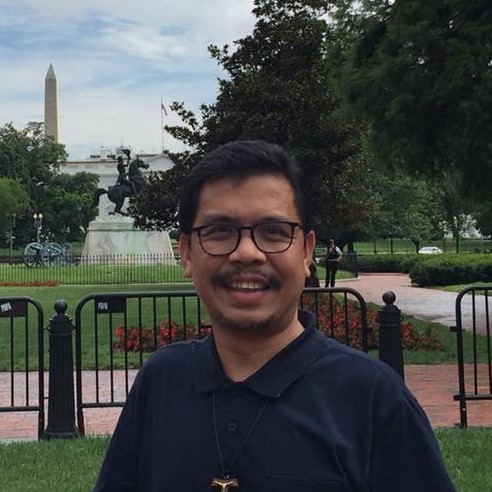
MEET FR. SAMUEL ACEBES CUARTO!
Personal Background
When you first meet Fr. Sam, his calm and kind demeanor immediately puts you at ease. He listens and observes intently, making it evident that he’s a studious man. Fr. Sam grew up in Bohol, Philippines which is an area that has extreme poverty due to climate change as the main income of its citizens is subsistence farming. Fr. Sam has been a Camillian priest for 23 years having been ordained in 1996 but was already thinking of committing his life to the Church as a child. When his father became sick, Fr. Sam was in high school and he bargained with God to heal his father and he would commit to becoming a priest. During this time Fr. Sam heard a representative from the Order of St. Camillus and was inspired by his words. Not long after, his father passed away and although Fr. Sam’s prayer for his health was not answered he still chose to commit his life to God and the Church.
Once Fr. Sam was ordained as a Camillian priest he was assigned as the Dean of Studies at the Seminary in the Philippines Province. After a while, he felt called to work in the more rural, impoverished communities and asked to be reassigned. He then spent time in a parish in a rural area where farmers and fisherman were in abundance much like his childhood in Bohol. After this assignment, he spent 8 years in Manila, Philippines at a long-term care facility helping to turn around the facilities business processes and care. However, Fr. Sam used his free time to work on development projects in the mountains with tribal communities and health projects in Manila for the poor and the sick.
During his time in Manilla, Fr. Sam had been working on a Ph.D. in Sociology but he took a leave of absence to travel to Rome to help Fr. Aris Miranda with CADIS International. He acted as the International Coordinator for CADIS International for 3 years. Fr. Sam decided not to return to finish his degree after his time with CADIS in Rome and was assigned to the Philippines as the Director of CADIS Philippines.
Working with CADIS
Fr. Sam has extensive experience in the field and has been part of the relief efforts in the following countries over the past few years:
Sierra Leone – The Ebola Crisis, 2014
Nepal – Earthquake, 2015
The Philippines – Typhoon Haiyan, 2015
Wajir, Kenya – Hunger, Food Insecurity, 2016.
For Fr. Sam the most memorable area he’s served in is Wajir, Kenya. It is a region that possesses so many threats to human life that it is hard to understand how the people living there survive. This area is very hot and the environment is all desert with a scarce ability to grow your own food. A terrorist group inhabits the area and brings a constant threat to Christians in the area. The community was 90% Muslim and because of the terrorist group's presence, many children were taught to hate Christians. This hatred from those so young was extremely difficult for Fr. Sam and the Sisters to endure. However, many of the Muslim spiritual leaders protected the Catholic priests and sisters working in Wajir. These leaders would send 15-30 men every night to protect the compound where Fr. Sam, the only priest, and five Sisters resided. Fr. Sam and the community of sisters were committed to researching the way in which more sustainable agriculture can be grown in Wajir. Fr. Sam shares words that his former professor once said, “Even in the most barren of places, you can grow food – You just need to be creative”. Fr. Sam and CADIS International continue to work to find a way to bring food security to the people of Wajir and hope to have a project implemented in this area in the next year.
For those who don’t know Fr. Sam well, he may not strike you as someone who feels comfortable in the field of suffering. But Fr. Sam believes that it is integral to being a Camillian. “When you go into the field you are closer to suffering. Poverty is suffering, vulnerability is suffering. We are able to witness to the compassion of these people.” He understands how hard it can be emotionally to be in the field and has even been so burnt out by his experiences that he has contemplated leaving the Order but he says that the other Religious of the Order help lessen the burden and so he continues this work to empower the vulnerable to build resiliency against the many threats to their health, safety, and life.
Being an MCP Speaker
Fr. Sam has enjoyed his time visiting parishes throughout the United States this Summer and is eager to return next summer. He has found that the Church communities here in the U.S. are passionate about attending Mass and worshipping. Many people are very generous in prayer and funds. He has been humbled by the warmth and hospitality he’s experienced in every parish from the Pastor to the housekeeping staff in the rectory. A personal joy from his MCP experience this summer is that Fr. Sam has been able to visit with many close and distant relatives and friends who live in the United States. He’s been able to spend time with these loved ones in between his Masses during MCP appeal weekends.
CADIS USA has been so blessed to have Fr. Sam visiting us this summer. We are so excited to have him return in 2019!
0 notes
Text
Ten popes later, world's oldest Sister dies
Ten popes later, world’s oldest Sister dies
The world’s oldest Sister, Candida Bellotti, has died at her Italian convent. She was 110. A professional nurse and since 1931 a “Camillian” – that is, a member of the Congregation of the Ministers of the Sick of Saint Camillus, Sister Candida lived under 10 popes. They were: Pius X (1903-1914); Benedict XV (1914-1922); Pius XI (1922-1939); Pius XII (1939-1958); John XXIII (1958-1963); Paul VI…
View On WordPress
0 notes
Text
110-Year-Old Nun's Secret To Long A Life Is Pretty Simple
One of the world’s oldest women says the key to a long life is love ― but for Sister Candida Bellotti that doesn’t mean the romantic kind.
Bellotti celebrated her 110th birthday on Monday surrounded by fellow sisters from her order. Her advice for a long life?
“Love, love and keep on loving. With joy!” the centenarian told journalists gathered for the special occasion at her Tuscan convent.
“Have faith in the future, and put in as much work as you can to make your wishes come true,” she added.
Bellotti was born on Feb. 20, 1907 in Verona, Italy. She became a nun with the Ministre degli Infermi di San Camillo, or Camillian nuns, at the age of 24 and also worked as a nurse across the country.
Bellotti has lived through two world wars, 10 popes and 57 Italian prime ministers, as Religion News Service noted.
The Italian nun got to meet Pope Francis on her 107th birthday when she journeyed the 230-some miles to Rome for Mass at Casa Santa Marta. Bellotti shared some tips for longevity on that occasion, too.
“Live a happy life!” the nun urged, adding that true joy comes from accepting things as they are. “True happiness is appreciating the moment as God gives it to us. ... Man needs to accept each moment that comes and say ‘thank you.’”
At 110, Bellotti isn’t the oldest nun alive. Another woman religious, Sister Marie-Josephine Gaudette, will celebrate her 115th birthday in March. Gaudette was born in New Hampshire but has lived in a convent in Italy since 1958.
Sister Teresita Barajuen, a centenarian nun from Spain, died in 2013 at the age of 105. Barajuen made headlines in 2011 when she left her Spanish monastery for the first time in 40 years to meet Pope Benedict XVI in Madrid.
Another centenarian, Jessie Gallan, died at the age of 109 in 2015 and said the key to a long life was avoiding men. Gallan wasn’t a nun, but she never married and swore by a longevity “diet” high in porridge and low in dudes.
-- This feed and its contents are the property of The Huffington Post, and use is subject to our terms. It may be used for personal consumption, but may not be distributed on a website.
110-Year-Old Nun's Secret To Long A Life Is Pretty Simple published first on http://ift.tt/2lnpciY
0 notes
Text
110-Year-Old Nun's Secret To Long A Life Is Pretty Simple
One of the world’s oldest women says the key to a long life is love ― but for Sister Candida Bellotti that doesn’t mean the romantic kind.
Bellotti celebrated her 110th birthday on Monday surrounded by fellow sisters from her order. Her advice for a long life?
“Love, love and keep on loving. With joy!” the centenarian told journalists gathered for the special occasion at her Tuscan convent.
“Have faith in the future, and put in as much work as you can to make your wishes come true,” she added.
Bellotti was born on Feb. 20, 1907 in Verona, Italy. She became a nun with the Ministre degli Infermi di San Camillo, or Camillian nuns, at the age of 24 and also worked as a nurse across the country.
Bellotti has lived through two world wars, 10 popes and 57 Italian prime ministers, as Religion News Service noted.
The Italian nun got to meet Pope Francis on her 107th birthday when she journeyed the 230-some miles to Rome for Mass at Casa Santa Marta. Bellotti shared some tips for longevity on that occasion, too.
“Live a happy life!” the nun urged, adding that true joy comes from accepting things as they are. “True happiness is appreciating the moment as God gives it to us. ... Man needs to accept each moment that comes and say ‘thank you.’”
youtube
At 110, Bellotti isn’t the oldest nun alive. Another woman religious, Sister Marie-Josephine Gaudette, will celebrate her 115th birthday in March. Gaudette was born in New Hampshire but has lived in a convent in Italy since 1958.
Sister Teresita Barajuen, a centenarian nun from Spain, died in 2013 at the age of 105. Barajuen made headlines in 2011 when she left her Spanish monastery for the first time in 40 years to meet Pope Benedict XVI in Madrid.
Another centenarian, Jessie Gallan, died at the age of 109 in 2015 and said the key to a long life was avoiding men. Gallan wasn’t a nun, but she never married and swore by a longevity “diet” high in porridge and low in dudes.
-- This feed and its contents are the property of The Huffington Post, and use is subject to our terms. It may be used for personal consumption, but may not be distributed on a website.
from http://ift.tt/2mmxnMX
from Blogger http://ift.tt/2l1kPtD
0 notes
Text
110-Year-Old Nun's Secret To Long A Life Is Pretty Simple
One of the world’s oldest women says the key to a long life is love ― but for Sister Candida Bellotti that doesn’t mean the romantic kind.
Bellotti celebrated her 110th birthday on Monday surrounded by fellow sisters from her order. Her advice for a long life?
“Love, love and keep on loving. With joy!” the centenarian told journalists gathered for the special occasion at her Tuscan convent.
“Have faith in the future, and put in as much work as you can to make your wishes come true,” she added.
Bellotti was born on Feb. 20, 1907 in Verona, Italy. She became a nun with the Ministre degli Infermi di San Camillo, or Camillian nuns, at the age of 24 and also worked as a nurse across the country.
Bellotti has lived through two world wars, 10 popes and 57 Italian prime ministers, as Religion News Service noted.
The Italian nun got to meet Pope Francis on her 107th birthday when she journeyed the 230-some miles to Rome for Mass at Casa Santa Marta. Bellotti shared some tips for longevity on that occasion, too.
“Live a happy life!” the nun urged, adding that true joy comes from accepting things as they are. “True happiness is appreciating the moment as God gives it to us. ... Man needs to accept each moment that comes and say ‘thank you.’”
youtube
At 110, Bellotti isn’t the oldest nun alive. Another woman religious, Sister Marie-Josephine Gaudette, will celebrate her 115th birthday in March. Gaudette was born in New Hampshire but has lived in a convent in Italy since 1958.
Sister Teresita Barajuen, a centenarian nun from Spain, died in 2013 at the age of 105. Barajuen made headlines in 2011 when she left her Spanish monastery for the first time in 40 years to meet Pope Benedict XVI in Madrid.
Another centenarian, Jessie Gallan, died at the age of 109 in 2015 and said the key to a long life was avoiding men. Gallan wasn’t a nun, but she never married and swore by a longevity “diet” high in porridge and low in dudes.
-- This feed and its contents are the property of The Huffington Post, and use is subject to our terms. It may be used for personal consumption, but may not be distributed on a website.
from Healthy Living - The Huffington Post http://huff.to/2mdjYHJ
0 notes
Photo
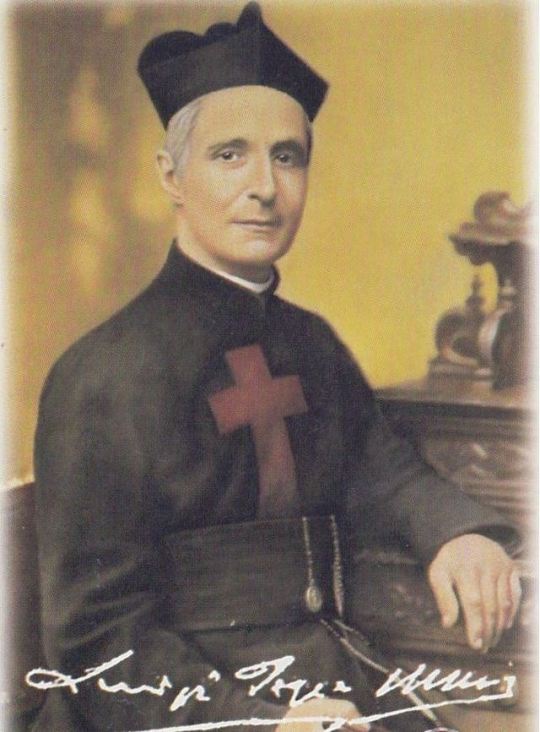
Today, 26 September is the memorial of Blessed Louis Tezza M.I. (1841-1923) the “Apostle of Lima”. Blessed Louis was an Italian priest, a professed member of the Camillians and Founder of the Daughters of St Camillus de Lellis M.I. (1550-1614), Apostle of Charity, Spiritual Director, Counsellor, Administrator, Teacher, Reformer, Advisor and is known as the Apostle of Lima. He was ordained in 1864 and went on to serve the sick and the poor in Peru. Tezza’s new religious congregation was established with the sole aim of sick relief who followed the Rule of the Camillian order as a branch of it. Patronage – Daughters of St Camillus. He was Beatified on 4 November 2001 by St Pope John Paul II.
Birth and youth
Fr Louis Tezza was born in Conegliano (TV) on 1st November 1841, the only son of Augustine Tezza and Cathetine Nedwiedt. His father, who was a medical doctor, died when Louis was nine and his mother decided to move to Padova, where Louis continued his studies. At the age of fifteen he entered the Camillian Order (Ministers of the Sick of St Camillus de Lellis). Having entrusted her son to the Camillian noviciate and being certain of the authenticity of his vocation, she herself entered the convent of the Visitation where she was renowned as an exceptional woman and religious sister.
After his ordination Louis was entrusted with the formation of the young religious. Four years later he was presented with an opportunity of fulfilling a long standing desire by becoming a missionary to Africa but obedience decreed that he obey his legitimate superiors who were not in favour of the venture. Instead of Africa, he was transferred to Rome as novice master.
In 1871 Fr Louis was sent to the new foundation in France as novice master, where he would later become the first provincial. Through his dedication and zeal he succeeded in establishing the common life within the community, while at the same time setting up specific Camillian social facilities in the local areas for the spiritual and corporal benefit of the sick. With the suppression of the religious institutes in 1880 he was expelled from France, as he was seen as a foreigner. However, he secretly returned and managed to unite the religious who were scattered here and there throughout the country. Thus he not alone resisted the suppression but he was responsible for laying the foundations for the development that would later follow.
He was elected Procurator and Vicar General of the Camillians in 1891 and on his return to Rome he providentially met Josephine Vannini (beatified on 16 October 1994). He had for some time cherished in his heart the desire to establish a group of consecrated women who would serve the sick in accordance with the spirit and charism of St Camillus de Lellis. Thus on the 2 February 1892, the Congregation of the Daughters of St Camillus was born, enriching the Camillian charism with the feminine characteristics of tenderness, hospitality, intuition and attentive listening. These were the very gifts which Camillus sought in his religious when they assisted the sick. The Institute was approved by the Holy See in 1931 and has experienced a rapid growth and expansion.
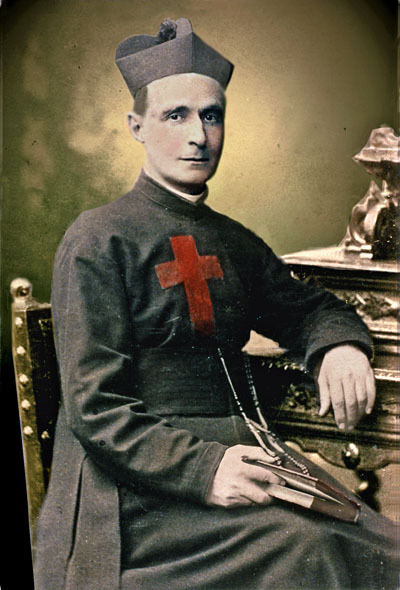
The Apostle of Lima
Just when it appeared that Fr Louis’ activity was drawing to a close, another very important chapter was about to be written. At the age of 59 he was sent to Peru as Official Visitor, with the brief of reforming the Camillian community of Lima, which for over a century had been separated from the Order and now risked being suppressed. This task was seen as involving a short stay in Lima but when the time to return to Rome came both the Archbishop and the Apostolic Nuncio considered his presence indispensable, defining him as “as a man inspired by God and providential for Lima”. He accepted their request, sanctioned by his superiors, as the will of God and entrusted all to Providence. Thus he remained in Lima for 23 years, until his death.
During this time he was to enrich his surroundings with his great charity and love of God, expressed through the exercise of an intense apostolic activity. Besides his work in re-establishing the regular life in the religious communities, he dedicated himself to the needs of the sick, especially those who were poor, in their homes, in the hospitals and in the prisons. He was confessor and spiritual director to the archdiocesan seminary and various religious Congregations. He was sought as a counsellor both in the Nunciature and in Archbishop’s House. He successfully helped another founder, the servant of God Teresa Candamo, overcome her initial difficulties with her new Institute.
His discreet work and intelligent and deep love, coupled with his loving and authoritative character, led to his being regarded as the “saint of Lima”. Here F. Louis died on 23 September 1923. An unknown visitor carved the words “Apostle of Lima” on his tomb.
He was described by the Cardinal Lauri as “the holiest priest in the diocese of Lima” and on his death the faithful distributed a remembrance card which highlights the main traits of his sanctity:
“he was sought after as a father and venerated as a saint – he is no longer with us but he continues to teach us from the tomb; his presence and comportment was angelic; his word was that that of a minister of the gospel; his heart a repository of noble affection; his mission was always salvific.
He passed among us as a heavenly vision, ever good and humble, always charitable. Faith was the basis of all his work while goodness enveloped him like a mantle and tiara”
His mortal remains are to be found in the Generalate of the Daughters of St Camillus on the Via Anagnina in Grottaferrata (Rome)….Vatican.va
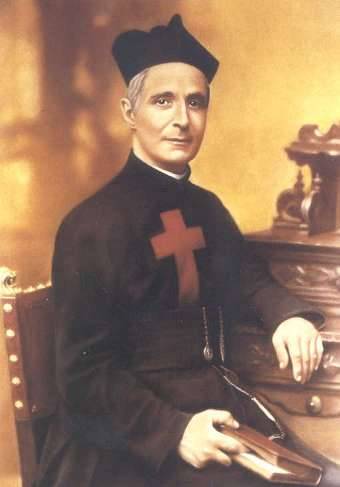

(via Saint of the Day - 26 September - Blessed Louis Tezza M.I. (1841-1923) the "Apostle of Lima")
9 notes
·
View notes
Text
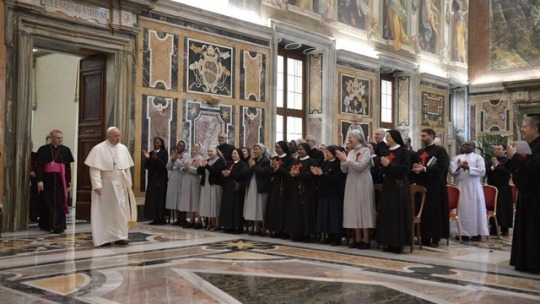
18th March >> (@Vaticannews) #PopeFrancis #Pope Francis to Camillians: Witnessing to the tenderness of God. Pope Francis meets with men and women religious of the Camillian Charismatic Family and tells them that listening is the key to sharing their charism of assisting the sick and the poor.
By Vatican News
Saint Camillus de Lellis founded the Order of Camillians, or Ministers to the Sick, over 400 years ago. Its identity has remained the same for over four centuries and finds its expression in the charism of mercy towards the sick.
Pope Francis referred to this charism when he met with members of the Order in the Vatican on Monday. When sickness comes and upsets our lives, he said, “we need a brother or sister beside us”, someone who is “compassionate and competent, and who consoles and supports us”.
Sharing the charism
The Pope praised the Members of the Camillian Charismatic Family for living their mission “in an exemplary way” by “assisting the sick, especially the poorest, in their bodily and spiritual needs, and teaching others the best way to serve them, for the benefit of the Church and of humanity”.
All charisms, continued Pope Francis, are gifts of the Holy Spirit, which are meant to be shared with others. “Over the years, you have endeavored to incarnate your charism faithfully”, he continued, “translating it into a multiplicity of apostolic works and pastoral service for the benefit of suffering humanity throughout the world”.
The original charism
The original mission and charism of Saint Camillus, said Pope Francis, is today reflected in a "charismatic family”, composed of religious, secular consecrated persons and laity. “At the center remains the original charism, as a perennial source of light and inspiration, which is understood and embodied dynamically in different forms”.
The Pope reminded his listeners how Saint Camillus de Lellis asked his first religious communities to serve the sick "with the affection that a loving mother usually has for her only sick child”. The two women's congregations that arose in the 19th century and the secular institutes founded in the last century, the Pope continued, “have given completeness to the expression of the charism of mercy towards the sick, enriching it with the markedly feminine qualities of love and care”.
The importance of listening
Pope Francis concluded by inviting the Camillian Charismatic Family to listen to one another, to the Holy Spirit, and “to the many forms of suffering and poverty of humanity today”. In this way, he said, you will shine with ever-new light, “and many young people from all over the world will feel drawn to it, and join you in continuing to bear witness to the tenderness of God”.
Topics
POPE FRANCIS
AUDIENCES
RELIGIOUS ORDERS
18th March 2019, 13:42
0 notes
Text
My 24th Birthday.
I haven’t been blogging lately, guess I was so busy with work that I actually can’t find time to share my stories. Anyways, last February 27, 2011 was my 24th birthday. I wanted it to be different this time. I don’t feel like throwing a big party with my friends or getting drunk and wasted. A couple of weeks before my birthday, I kept on thinking what I really want. Then I realized that I wanted to make other people happy, not necessarily my friends. I thought of celebrating it with kids in an orphanage but I realized that these kids can still hope for someone to adopt them and give them the love (of family) that they need. So I decided to celebrate my birthday with the elderly people in a home for the aged institution, since these people were left behind by their family and what, let’s admit it, their like just waiting for their time to end. I asked my Bestfriend Steph if she could help me organize and look for a home for the aged institution that is not popular since I believe that they don’t get donations that often compared to the popular ones. We chose Bahay Kanlungan ni Maria by Camillian Sisters in Antipolo, which consists of around 25 lolas. So I told my closest friends about my plan right away and they said that it was a good idea. I bought food and also gathered some donations from my friends and I was happy that my mom and dad also supported my plan that they even bought towels for the lolas to serve as giveaways. I also asked my closest friends to join me make the Lolas happy by spending a little of our time with them. We prepared a little program for them wherein we tried to get to know them through some games since they love to share their stories to other people, we prepared a little intermission number for them to be entertained, and danced with them as well. I also remembered that before our program started, they asked me to go infront and the Lolas greeted me a happy birthday and gave a little message. It really did touch my heart and I can’t explain the happiness that I felt during the time that I spent my birthday with them. It was a great fulfillment to make the Lolas happy and I‘m glad that I am surrounded by great people who are also willing to share their love to these Lolas. Thank you again (you guys know who you are)! You guys are the BEST!
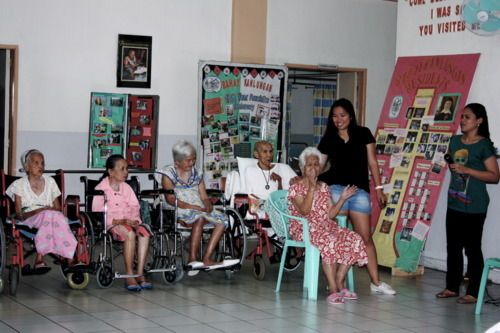

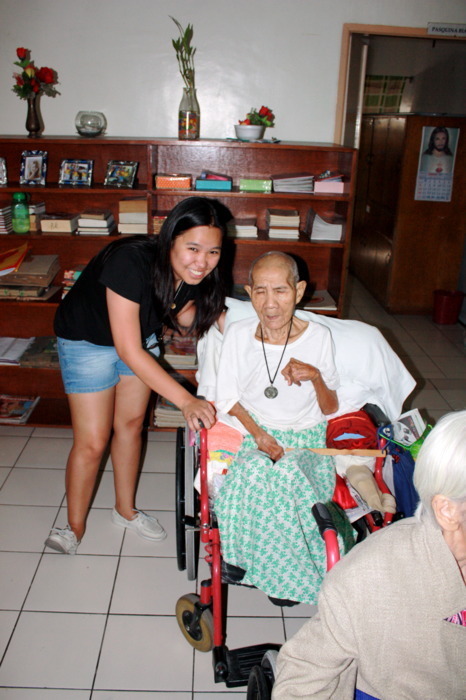








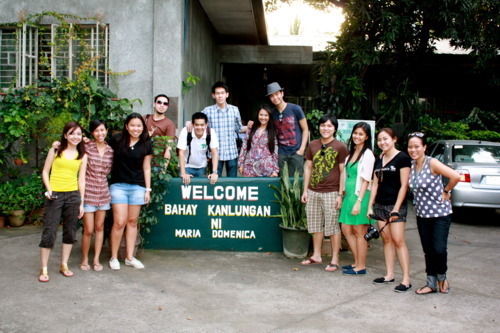
2 notes
·
View notes